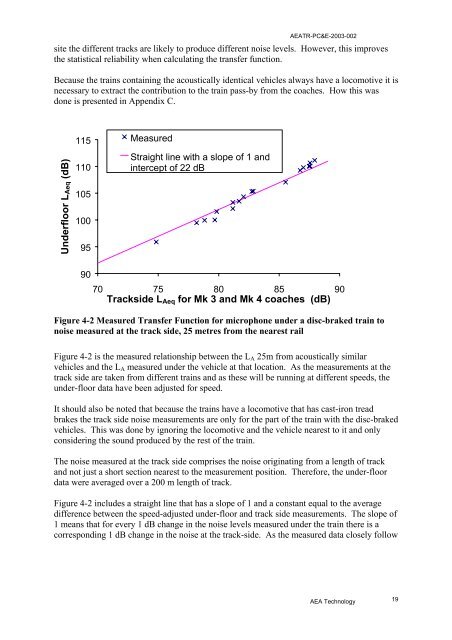Rail and wheel roughness - implications for noise ... - ARCHIVE: Defra
Rail and wheel roughness - implications for noise ... - ARCHIVE: Defra
Rail and wheel roughness - implications for noise ... - ARCHIVE: Defra
Create successful ePaper yourself
Turn your PDF publications into a flip-book with our unique Google optimized e-Paper software.
AEATR-PC&E-2003-002<br />
site the different tracks are likely to produce different <strong>noise</strong> levels. However, this improves<br />
the statistical reliability when calculating the transfer function.<br />
Because the trains containing the acoustically identical vehicles always have a locomotive it is<br />
necessary to extract the contribution to the train pass-by from the coaches. How this was<br />
done is presented in Appendix C.<br />
Underfloor LAeq (dB)<br />
115<br />
110<br />
105<br />
100<br />
95<br />
Measured<br />
Straight line with a slope of 1 <strong>and</strong><br />
intercept of 22 dB<br />
90<br />
70 75 80 85 90<br />
Trackside L Aeq <strong>for</strong> Mk 3 <strong>and</strong> Mk 4 coaches (dB)<br />
Figure 4-2 Measured Transfer Function <strong>for</strong> microphone under a disc-braked train to<br />
<strong>noise</strong> measured at the track side, 25 metres from the nearest rail<br />
Figure 4-2 is the measured relationship between the L A 25m from acoustically similar<br />
vehicles <strong>and</strong> the L A measured under the vehicle at that location. As the measurements at the<br />
track side are taken from different trains <strong>and</strong> as these will be running at different speeds, the<br />
under-floor data have been adjusted <strong>for</strong> speed.<br />
It should also be noted that because the trains have a locomotive that has cast-iron tread<br />
brakes the track side <strong>noise</strong> measurements are only <strong>for</strong> the part of the train with the disc-braked<br />
vehicles. This was done by ignoring the locomotive <strong>and</strong> the vehicle nearest to it <strong>and</strong> only<br />
considering the sound produced by the rest of the train.<br />
The <strong>noise</strong> measured at the track side comprises the <strong>noise</strong> originating from a length of track<br />
<strong>and</strong> not just a short section nearest to the measurement position. There<strong>for</strong>e, the under-floor<br />
data were averaged over a 200 m length of track.<br />
Figure 4-2 includes a straight line that has a slope of 1 <strong>and</strong> a constant equal to the average<br />
difference between the speed-adjusted under-floor <strong>and</strong> track side measurements. The slope of<br />
1 means that <strong>for</strong> every 1 dB change in the <strong>noise</strong> levels measured under the train there is a<br />
corresponding 1 dB change in the <strong>noise</strong> at the track-side. As the measured data closely follow<br />
AEA Technology 19
















